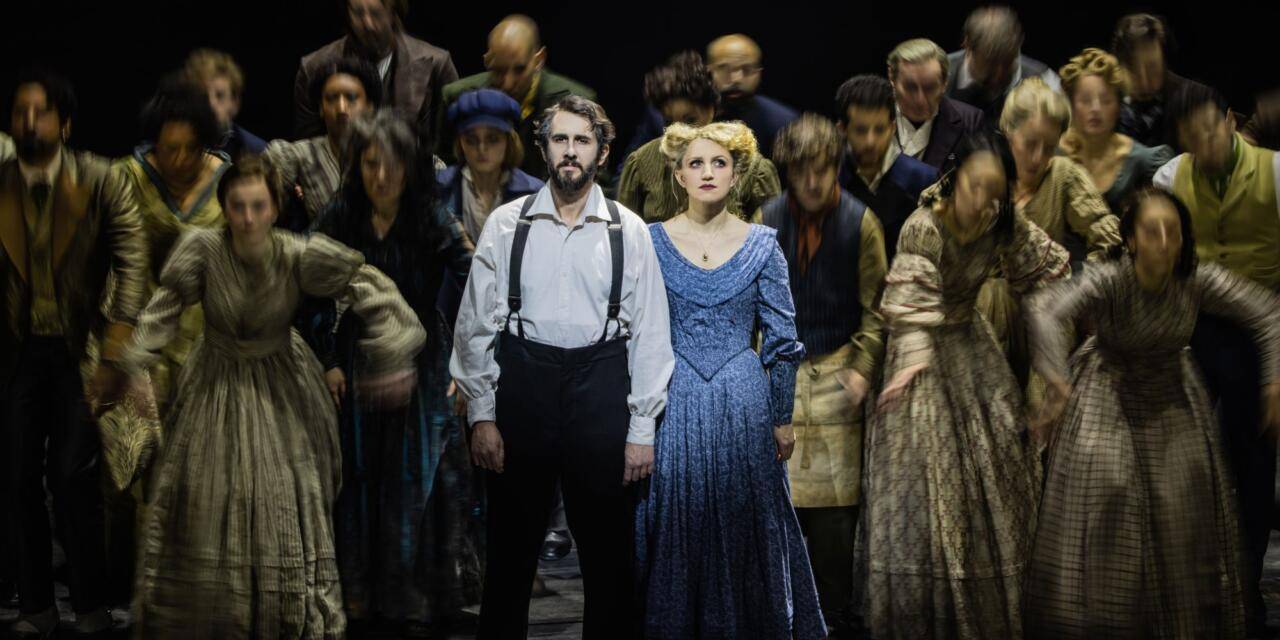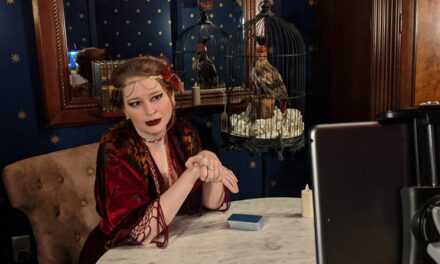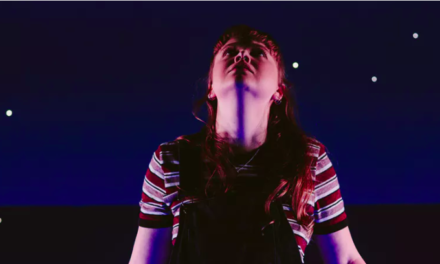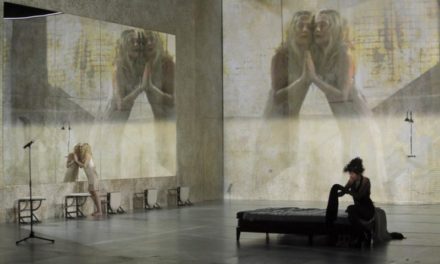Up to the present moment a debate has been going on – whether the demon-barber of Fleet Street had a real-life prototype.
For the very first time, a character under the name of Sweeney Todd appeared in the series of Penny Dreadful stories written by Thomas Peckett Prest in 1846. Later, the stories were collected into a single novel A String of Pearls. There have been some doubts and differences in opinions when it came to the authorship of the novel: some believed that the book was written by Thomas Peckett Prest, and others were convinced that it was a creative work by James Malcolm Rymer.
The story of a bloodthirsty barber-murderer gained popularity rather quickly and had a multitude of stage and film adaptations (1926, 1928, 1936, 1947, 1970, 1997, 2006, 2007). All existing screen versions can be divided into two categories: inspired by the Penny Dreadfuls and based on the 1970 play Sweeney Todd by Christopher Bond. Bond intricately added the much-needed tragic motives to the criminal story by Thomas Peckett Prest. Thanks to Christopher Bond, Sweeney Todd transformed from a vile criminal into an outsider. The demonic origin of the greedy creature yielded to the just thirst for revenge toward the offenders of the falsely accused and condemned (in analogy to the noble Count of Monte Cristo).
All fifteen years of imprisonment Todd looked forward to seeing his beloved wife and daughter again, they were taken from him by a cruel judge who essentially sent him to prison. That is the story told in the musical Sweeney Todd: The Demon Barber of Fleet Street (1979) written by Stephen Sondheim (music and lyrics), Hugh Wheeler (book) and directed by Harold Prince. Actors Len Cariou and Angela Lansbury created characters that were different from the ones on the silver screen. Sweeney Todd was not supposed to be an operetta villain, even though the composer himself characterized his piece as a “dark operetta.” Together with Angela Lansbury, who played the comedic character role of a practical and perfidious owner of a Pie Shop – Mrs. Lovett, they established a classic duet of two maniac murderers. The negative qualities of the heroine were so over-stressed that they seemed funny. At that, she is the leader and the main mastermind behind the cannibal duet A Little Priest. The sinister energy coming from Mrs. Lovett made the audience sink into a kind of nightmarish stupor.
In Tim Burton’s movie (2007) due to the considerable cutting down of the musical material that specific atmosphere gave place to the melancholic mood coming from Todd. He remains indifferent to Mrs. Lovett’s feelings. The blend of horror and charm, which was present in the original Broadway production, got lost in the film version. Certainly, thanks to the character of Todd created by Johnny Depp. For the first time in the long row of actors who portrayed Sweeney Todd, Johnny introduced Sweeney as a deep and multifaceted person. Indeed, he is not the same absolute villain that we’ve imagined after reading the original novel. His demonic side has been reduced considerably. At that, Tim Burton, essentially, shot a gothic fairy tale, and there can be no absolute Evil or absolute Good in a fairy tale. In his recognizable style, the director skillfully adapted Sondheim’s musical, having undertaken certain necessary abridgments of musical material and transformations of the plot lines. Due to the London entourage of Victorian England, the black-and-white color scheme of the movie accentuates the tragedy and doom of what happens in the story. The rare inclusions of color in Mrs. Lovett’s dream sequences serve as counterpoints of perception and emphasize the “dark fairy tale” genre of the piece. Johnny Depp and Helena Bonham Carter, two amazing actors, were able to realistically tell the story of an outsider bent on revenge, implanted in the mad aesthetics of the director.
As is well known, the musical came to Broadway three times: with Bob Gunton and Beth Fowler (1989), Michael Cerveris and Patti LuPone (2005), and Josh Groban and Annaleigh Ashford (2023). The first revival turned out to be not as grand as the original. Mainly it was due to the limited budget of the production. But despite that, the show pretty much resembled the original one. And Bob Gunton together with Beth Fowler have accomplished the practically impossible: they have left the operettic, classical style of singing behind and performed in the modern musical theater manner. Which most definitely affected the overall perception of the production. The show was christened as the “gothic musical,” rather than – a “dark operetta.” The terrific acting skills of the performers did the trick: the show seemed well-balanced, was very captivating, and left a pleasant aftertaste of an intricate masterpiece.
The second Broadway revival (2005) recreated the minimalist London production by John Doyle (2004), where there was no orchestra, and the performers themselves played musical instruments on stage. Sweeney Todd (Michael Cerveris) was dressed in modern clothes: a white shirt and tie, and a leather cloak. At that, it was unusual to see a bald Sweeney Todd. Mrs. Lovett (Patti LuPone) who used to be blonde originally, turned into a brunette, a sort of femme fatale. Also dressed in modern garments. Just like all the other cast members, Todd played the guitar, and Mrs. Lovett – played drums and a tuba. If the singing part of the show was unquestionable, then the production itself was simply less than perfect. But experiments are quite welcome, so in the piggy bank of remakes we have one as such.
The latest Broadway revival of the show has come around full circle and put everything back in its rightful place: the orchestra, the set, and the amazing lighting design. Such a performance would have been characterized by Sondheim himself as a “grandiose,” in no way a “chamber” production, not like the very first remake or the following experimental revival.
Perhaps since the show premiered after the latest movie by Tim Burton, Thomas Kail, the director of the Broadway musical, took a very important step toward the development of the main characters. Initially, Sondheim has been searching for a way to combine tragedy and comedy, so that the inner horror was evoked not by the terrifying scenes of murder with rivers of blood but by the discords: between the light music and the horrifying turn of the storyline, the witty tone and the serious text. All of this exists in the music score and libretto of the musical. Annaleigh Ashford, the actress who portrayed Mrs. Lovett – was able to realize this task in earnest. Ashford’s acting is “over the top,” which turns her into a comedic character, but at that – she is the main accomplice of the crimes, at the very least. And at the most – she is the driving force of the story which counterbalances the passive Sweeney Todd. She – is that very gem that shines so bright that it conceals all other shortcomings of the production. First of all, she disguises the issue of the lost character of Sweeney Todd as performed by Josh Groban. Groban is missing the main key to the character of Todd: the demonic and obsessive side, which pretty much is crucial for psychopaths. Humor – is something that Mrs. Lovett is missing in the movie (as performed by Helena Bonham Carter), but in the recent Broadway production that dark sense of humor is provided by Annaleigh Ashford in an effective quantity.
What is also important to note is that the concept and tone of the representation of history have changed over time. If in early screen versions and theatrical productions, as in some of the early productions of the musical – it was a melodrama with some elements of horror, then in Burton’s movie and the recent revival we can officially characterize it as a criminal thriller. And even though according to the rules of the genre, the spectator finds him or herself in a state of emotional tension, awaiting the negative resolution of the story, in their heart of hearts, the spectators empathize with the main character.
If we analyze the reviews of the current Broadway revival of the musical Sweeney Todd: The Demon Barber of Fleet Street, then in addition to the statement of the fact that Josh Groban’s level of acting skills is “not good enough” to play such a character as Sweeney Todd, as well as the fact that Mrs. Lovett is fantastic, we will discover an interest in the character of Johanna. It is not quite clear though why the director decided to bestow Tourette’s syndrome upon her when she is experiencing “tic-like” convulsive arm movements that are the harbingers of seizures. The analogy with a canary, locked up in a cage, didn’t come through. Unless there was a parrot in that cage and not a canary. In any case, the actress was successful in attracting everyone’s attention.
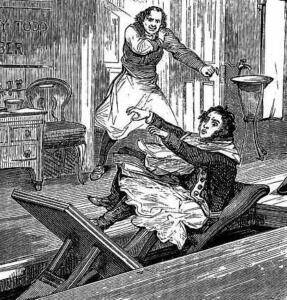
Sweeney Todd illustration from the original Penny Dreadfuls
None of the theater critics and writers missed the opportunity to single out the major prop of the show – the barber chair, which was delivered to Todd “live,” with the help of a rigging crane. Creative theatrics are always much appreciated, but… The very first folding barber chair appeared at the beginning of the 20th century, almost one hundred years after the events that took place in the story of Sweeney Todd… That’s not even the main issue here. One of the major peculiarities of the original story was the actual structure of the rotation gear of the barber chair which Sweeney Todd came up with himself, as he was also a talented engineer. It looked like a turning platform, with two identical chairs screwed into it on both sides. With the help of a hidden lever, the platform would flip over, and the victim would fall from the chair into the cellar, breaking his or her neck in the process. At the same time, a new chair would appear in the room instead, only it would be empty. Therefore, Todd could never be caught red-handed and there were no blood marks on the floor. He would finish his victims off in the cellar, slitting their throats with a razor before dismembering them. Besides, most screen versions of the tale demonstrate that very means of disposing of victims. I believe, that if the producers realized such a special effect with the barber chair that would turn 180 degrees and flip around, it could have taken an honorable place in the row of legendary props and set pieces, right next to the falling chandelier from Andrew Lloyd Webber’s mega-musical The Phantom of the Opera. Especially, since the set in Sweeney Todd already had two levels to it, so technically, such a task with the barber chair could have been accomplished.
The ensemble was lovely, dressed in beautiful costumes, and the performers were extremely skillful singers and dancers, the only issue was that the ensemble failed to become a connecting link within the production, even though it was supposed to be. The choreography didn’t come together as a whole and sometimes looked like a dissonance compared to the realistic action.
Some will say – so many men, so many minds, each will have their own opinion. And that is fair. Stephen Sondheim’s music though always has positive connotations. Such musical masterpieces as The Ballad of Sweeney Todd, No Place Like London, Pretty Women, Epiphany, A Little Priest, Johanna, By the Sea, and City on Fire performed by a wonderful orchestra and conducted by Kristen Blodgette will sound in the spectators’ heads long after they leave the theater.
Having written such a magnificent and complicated music score, Stephen Sondheim provided undying interest in his masterpiece as well as its main hero, one of the main characters in The Gallery of Outsiders – Sweeney Todd. The number of productions of this musical, excluding those made by opera casts, counts over thirty. Undoubtedly, the spectators will witness many more remakes and revivals of the musical Sweeney Todd: The Demon Barber of Fleet Street. And the character of the demon-barber will keep transforming. The principal idea embedded by Stephen Sondheim in his music and story must be preserved – the duplicity of nature of the main character is extremely important – he even possesses two names (Benjamin Barker/ Sweeney Todd), two faces (the barber/ the murderer), two essences (human/ demonic).
This post was written by the author in their personal capacity.The opinions expressed in this article are the author’s own and do not reflect the view of The Theatre Times, their staff or collaborators.
This post was written by Lisa Monde.
The views expressed here belong to the author and do not necessarily reflect our views and opinions.

